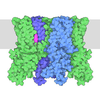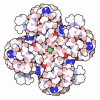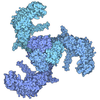[English] 日本語
 Yorodumi
Yorodumi- EMDB-70275: Cryo-EM structure of KCa3.1/calmodulin channel in complex with NS309 -
+ Open data
Open data
- Basic information
Basic information
| Entry |  | |||||||||||||||
|---|---|---|---|---|---|---|---|---|---|---|---|---|---|---|---|---|
| Title | Cryo-EM structure of KCa3.1/calmodulin channel in complex with NS309 | |||||||||||||||
 Map data Map data | Cryo-EM map of KCa3.1/calmodulin channel in complex with NS309 | |||||||||||||||
 Sample Sample |
| |||||||||||||||
 Keywords Keywords | Ion channel / Intermediate conductance calcium-activated potassium channel / Calmodulin binding protein / TRANSPORT PROTEIN | |||||||||||||||
| Function / homology |  Function and homology information Function and homology informationintermediate conductance calcium-activated potassium channel activity / saliva secretion / small conductance calcium-activated potassium channel activity / Ca2+ activated K+ channels / stabilization of membrane potential / macropinocytosis / calcium-activated potassium channel activity / regulation of calcium ion import across plasma membrane / establishment of protein localization to mitochondrial membrane / positive regulation of potassium ion transmembrane transport ...intermediate conductance calcium-activated potassium channel activity / saliva secretion / small conductance calcium-activated potassium channel activity / Ca2+ activated K+ channels / stabilization of membrane potential / macropinocytosis / calcium-activated potassium channel activity / regulation of calcium ion import across plasma membrane / establishment of protein localization to mitochondrial membrane / positive regulation of potassium ion transmembrane transport / type 3 metabotropic glutamate receptor binding / establishment of protein localization to membrane / cell volume homeostasis / phospholipid translocation / negative regulation of ryanodine-sensitive calcium-release channel activity / organelle localization by membrane tethering / mitochondrion-endoplasmic reticulum membrane tethering / autophagosome membrane docking / negative regulation of calcium ion export across plasma membrane / regulation of cardiac muscle cell action potential / presynaptic endocytosis / nitric-oxide synthase binding / positive regulation of T cell receptor signaling pathway / regulation of synaptic vesicle exocytosis / calcineurin-mediated signaling / adenylate cyclase binding / regulation of ryanodine-sensitive calcium-release channel activity / protein phosphatase activator activity / immune system process / detection of calcium ion / regulation of synaptic vesicle endocytosis / regulation of cardiac muscle contraction / potassium channel activity / catalytic complex / postsynaptic cytosol / cellular response to interferon-beta / phosphatidylinositol 3-kinase binding / calcium channel inhibitor activity / presynaptic cytosol / regulation of release of sequestered calcium ion into cytosol by sarcoplasmic reticulum / titin binding / sperm midpiece / regulation of calcium-mediated signaling / voltage-gated potassium channel complex / potassium ion transmembrane transport / calcium channel complex / regulation of heart rate / calyx of Held / response to amphetamine / adenylate cyclase activator activity / sarcomere / protein serine/threonine kinase activator activity / nitric-oxide synthase regulator activity / regulation of cytokinesis / positive regulation of protein secretion / spindle microtubule / positive regulation of receptor signaling pathway via JAK-STAT / calcium channel regulator activity / establishment of localization in cell / defense response / response to calcium ion / potassium ion transport / cellular response to type II interferon / G2/M transition of mitotic cell cycle / Schaffer collateral - CA1 synapse / ruffle membrane / spindle pole / calcium-dependent protein binding / calcium ion transport / myelin sheath / growth cone / protein phosphatase binding / protein homotetramerization / vesicle / transmembrane transporter binding / calmodulin binding / neuron projection / protein domain specific binding / neuronal cell body / calcium ion binding / centrosome / protein kinase binding / protein homodimerization activity / protein-containing complex / mitochondrion / nucleoplasm / plasma membrane / cytoplasm / cytosol Similarity search - Function | |||||||||||||||
| Biological species |  Homo sapiens (human) / Homo sapiens (human) /  | |||||||||||||||
| Method | single particle reconstruction / cryo EM / Resolution: 3.59 Å | |||||||||||||||
 Authors Authors | Nam YW / Zhang M | |||||||||||||||
| Funding support |  United States, 4 items United States, 4 items
| |||||||||||||||
 Citation Citation |  Journal: Res Sq / Year: 2025 Journal: Res Sq / Year: 2025Title: Structural basis for the subtype-selectivity of K2.2 channel activators. Authors: Miao Zhang / Young-Woo Nam / Alena Ramanishka / Yang Xu / Rose Marie Yasuda / Dohyun Im / Meng Cui / George Chandy / Heike Wulff /  Abstract: Small-conductance (K2.2) and intermediate-conductance (K3.1) Ca-activated K channels are gated by a Ca-calmodulin dependent mechanism. NS309 potentiates the activity of both K2.2 and K3.1, while ...Small-conductance (K2.2) and intermediate-conductance (K3.1) Ca-activated K channels are gated by a Ca-calmodulin dependent mechanism. NS309 potentiates the activity of both K2.2 and K3.1, while rimtuzalcap selectively activates K2.2. Rimtuzalcap has been used in clinical trials for the treatment of spinocerebellar ataxia and essential tremor. We report cryo-electron microscopy structures of K2.2 channels bound with NS309 and rimtuzalcap, in addition to K3.1 channels with NS309. The different conformations of calmodulin and the cytoplasmic HC helices in the two channels underlie the subtype-selectivity of rimtuzalcap for K2.2. Calmodulin's N-lobes in the K2.2 structure are far apart and undergo conformational changes to accommodate either NS309 or rimtuzalcap. Calmodulin's Nlobes in the K3.1 structure are closer to each other and are constrained by the HC helices of K3.1, which allows binding of NS309 but not of the bulkier rimtuzalcap. These structures provide a framework for structure-based drug design targeting K2.2 channels. | |||||||||||||||
| History |
|
- Structure visualization
Structure visualization
| Supplemental images |
|---|
- Downloads & links
Downloads & links
-EMDB archive
| Map data |  emd_70275.map.gz emd_70275.map.gz | 433.1 MB |  EMDB map data format EMDB map data format | |
|---|---|---|---|---|
| Header (meta data) |  emd-70275-v30.xml emd-70275-v30.xml emd-70275.xml emd-70275.xml | 21.6 KB 21.6 KB | Display Display |  EMDB header EMDB header |
| Images |  emd_70275.png emd_70275.png | 342.4 KB | ||
| Filedesc metadata |  emd-70275.cif.gz emd-70275.cif.gz | 6.8 KB | ||
| Others |  emd_70275_half_map_1.map.gz emd_70275_half_map_1.map.gz emd_70275_half_map_2.map.gz emd_70275_half_map_2.map.gz | 441.5 MB 441.5 MB | ||
| Archive directory |  http://ftp.pdbj.org/pub/emdb/structures/EMD-70275 http://ftp.pdbj.org/pub/emdb/structures/EMD-70275 ftp://ftp.pdbj.org/pub/emdb/structures/EMD-70275 ftp://ftp.pdbj.org/pub/emdb/structures/EMD-70275 | HTTPS FTP |
-Validation report
| Summary document |  emd_70275_validation.pdf.gz emd_70275_validation.pdf.gz | 885.3 KB | Display |  EMDB validaton report EMDB validaton report |
|---|---|---|---|---|
| Full document |  emd_70275_full_validation.pdf.gz emd_70275_full_validation.pdf.gz | 884.9 KB | Display | |
| Data in XML |  emd_70275_validation.xml.gz emd_70275_validation.xml.gz | 18.2 KB | Display | |
| Data in CIF |  emd_70275_validation.cif.gz emd_70275_validation.cif.gz | 21.8 KB | Display | |
| Arichive directory |  https://ftp.pdbj.org/pub/emdb/validation_reports/EMD-70275 https://ftp.pdbj.org/pub/emdb/validation_reports/EMD-70275 ftp://ftp.pdbj.org/pub/emdb/validation_reports/EMD-70275 ftp://ftp.pdbj.org/pub/emdb/validation_reports/EMD-70275 | HTTPS FTP |
-Related structure data
| Related structure data |  9oa8MC  9o7sC  9o85C  9o93C M: atomic model generated by this map C: citing same article ( |
|---|---|
| Similar structure data | Similarity search - Function & homology  F&H Search F&H Search |
- Links
Links
| EMDB pages |  EMDB (EBI/PDBe) / EMDB (EBI/PDBe) /  EMDataResource EMDataResource |
|---|---|
| Related items in Molecule of the Month |
- Map
Map
| File |  Download / File: emd_70275.map.gz / Format: CCP4 / Size: 476.8 MB / Type: IMAGE STORED AS FLOATING POINT NUMBER (4 BYTES) Download / File: emd_70275.map.gz / Format: CCP4 / Size: 476.8 MB / Type: IMAGE STORED AS FLOATING POINT NUMBER (4 BYTES) | ||||||||||||||||||||||||||||||||||||
|---|---|---|---|---|---|---|---|---|---|---|---|---|---|---|---|---|---|---|---|---|---|---|---|---|---|---|---|---|---|---|---|---|---|---|---|---|---|
| Annotation | Cryo-EM map of KCa3.1/calmodulin channel in complex with NS309 | ||||||||||||||||||||||||||||||||||||
| Projections & slices | Image control
Images are generated by Spider. | ||||||||||||||||||||||||||||||||||||
| Voxel size | X=Y=Z: 0.86 Å | ||||||||||||||||||||||||||||||||||||
| Density |
| ||||||||||||||||||||||||||||||||||||
| Symmetry | Space group: 1 | ||||||||||||||||||||||||||||||||||||
| Details | EMDB XML:
|
-Supplemental data
-Half map: Cryo-EM half map of KCa3.1/calmodulin channel in complex with NS309
| File | emd_70275_half_map_1.map | ||||||||||||
|---|---|---|---|---|---|---|---|---|---|---|---|---|---|
| Annotation | Cryo-EM half map of KCa3.1/calmodulin channel in complex with NS309 | ||||||||||||
| Projections & Slices |
| ||||||||||||
| Density Histograms |
-Half map: Cryo-EM half map of KCa3.1/calmodulin channel in complex with NS309
| File | emd_70275_half_map_2.map | ||||||||||||
|---|---|---|---|---|---|---|---|---|---|---|---|---|---|
| Annotation | Cryo-EM half map of KCa3.1/calmodulin channel in complex with NS309 | ||||||||||||
| Projections & Slices |
| ||||||||||||
| Density Histograms |
- Sample components
Sample components
-Entire : Human KCa3.1/calmodulin channel in complex with NS309
| Entire | Name: Human KCa3.1/calmodulin channel in complex with NS309 |
|---|---|
| Components |
|
-Supramolecule #1: Human KCa3.1/calmodulin channel in complex with NS309
| Supramolecule | Name: Human KCa3.1/calmodulin channel in complex with NS309 / type: complex / ID: 1 / Parent: 0 / Macromolecule list: #1-#2 |
|---|---|
| Source (natural) | Organism:  Homo sapiens (human) Homo sapiens (human) |
| Molecular weight | Theoretical: 231.66 KDa |
-Macromolecule #1: Intermediate conductance calcium-activated potassium channel protein 4
| Macromolecule | Name: Intermediate conductance calcium-activated potassium channel protein 4 type: protein_or_peptide / ID: 1 / Number of copies: 4 / Enantiomer: LEVO |
|---|---|
| Source (natural) | Organism:  Homo sapiens (human) Homo sapiens (human) |
| Molecular weight | Theoretical: 42.598633 KDa |
| Recombinant expression | Organism:  Homo sapiens (human) Homo sapiens (human) |
| Sequence | String: LGALRRRKRL LEQEKSLAGW ALVLAGTGIG LMVLHAEMLW FGGCSWALYL FLVKCTISIS TFLLLCLIVA FHAKEVQLFM TDNGLRDWR VALTGRQAAQ IVLELVVCGL HPAPVRGPPC VQDLGAPLTS PQPWPGFLGQ GEALLSLAML LRLYLVPRAV L LRSGVLLN ...String: LGALRRRKRL LEQEKSLAGW ALVLAGTGIG LMVLHAEMLW FGGCSWALYL FLVKCTISIS TFLLLCLIVA FHAKEVQLFM TDNGLRDWR VALTGRQAAQ IVLELVVCGL HPAPVRGPPC VQDLGAPLTS PQPWPGFLGQ GEALLSLAML LRLYLVPRAV L LRSGVLLN ASYRSIGALN QVRFRHWFVA KLYMNTHPGR LLLGLTLGLW LTTAWVLSVA ERQAVNATGH LSDTLWLIPI TF LTIGYGD VVPGTMWGKI VCLCTGVMGV CCTALLVAVV ARKLEFNKAE KHVHNFMMDI QYTKEMKESA ARVLQEAWMF YKH TRRKES HAARRHQRKL LAAINAFRQV RLKHRKLREQ VNSMVDISKM HMILYDLQQN LS UniProtKB: Intermediate conductance calcium-activated potassium channel protein 4 |
-Macromolecule #2: Calmodulin-1
| Macromolecule | Name: Calmodulin-1 / type: protein_or_peptide / ID: 2 / Number of copies: 4 / Enantiomer: LEVO |
|---|---|
| Source (natural) | Organism:  |
| Molecular weight | Theoretical: 16.521094 KDa |
| Recombinant expression | Organism:  Homo sapiens (human) Homo sapiens (human) |
| Sequence | String: DQLTEEQIAE FKEAFSLFDK DGDGTITTKE LGTVMRSLGQ NPTEAELQDM INEVDADGNG TIDFPEFLTM MARKMKDTDS EEEIREAFR VFDKDGNGYI SAAELRHVMT NLGEKLTDEE VDEMIREADI DGDGQVNYEE FVQMMTA UniProtKB: Calmodulin-1 |
-Macromolecule #3: POTASSIUM ION
| Macromolecule | Name: POTASSIUM ION / type: ligand / ID: 3 / Number of copies: 3 / Formula: K |
|---|---|
| Molecular weight | Theoretical: 39.098 Da |
-Macromolecule #4: (3E)-6,7-dichloro-3-(hydroxyimino)-1,3-dihydro-2H-indol-2-one
| Macromolecule | Name: (3E)-6,7-dichloro-3-(hydroxyimino)-1,3-dihydro-2H-indol-2-one type: ligand / ID: 4 / Number of copies: 4 / Formula: 1KP |
|---|---|
| Molecular weight | Theoretical: 231.036 Da |
| Chemical component information |  ChemComp-1KP: |
-Macromolecule #5: CALCIUM ION
| Macromolecule | Name: CALCIUM ION / type: ligand / ID: 5 / Number of copies: 8 / Formula: CA |
|---|---|
| Molecular weight | Theoretical: 40.078 Da |
-Experimental details
-Structure determination
| Method | cryo EM |
|---|---|
 Processing Processing | single particle reconstruction |
| Aggregation state | particle |
- Sample preparation
Sample preparation
| Concentration | 2 mg/mL |
|---|---|
| Buffer | pH: 8 |
| Vitrification | Cryogen name: ETHANE |
- Electron microscopy
Electron microscopy
| Microscope | TFS KRIOS |
|---|---|
| Image recording | Film or detector model: FEI FALCON IV (4k x 4k) / Average electron dose: 50.0 e/Å2 |
| Electron beam | Acceleration voltage: 300 kV / Electron source:  FIELD EMISSION GUN FIELD EMISSION GUN |
| Electron optics | Illumination mode: FLOOD BEAM / Imaging mode: BRIGHT FIELD / Nominal defocus max: 2.2 µm / Nominal defocus min: 1.3 µm |
| Sample stage | Specimen holder model: FEI TITAN KRIOS AUTOGRID HOLDER |
| Experimental equipment |  Model: Titan Krios / Image courtesy: FEI Company |
 Movie
Movie Controller
Controller










 X (Sec.)
X (Sec.) Y (Row.)
Y (Row.) Z (Col.)
Z (Col.)





































